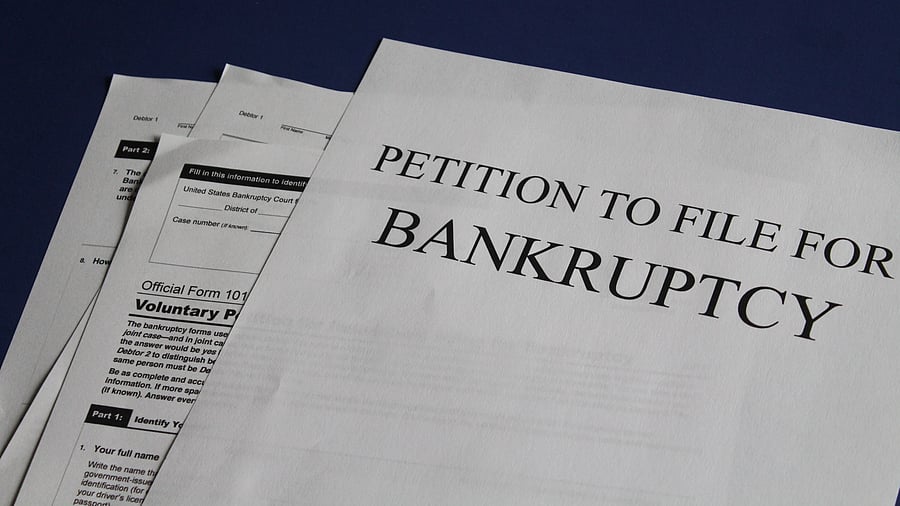
Representative image showing a petition to file for bankruptcy.
Credit: Unsplash
The 2016 Insolvency and Bankruptcy Code (IBC) has been in the news for the amendments the government is proposing to further sharpen the code: be it on a project-wise resolution in the real estate sector, or making it easier for lessors to recover aircraft when airlines go bankrupt.
The primary challenge within the existing insolvency framework lies in the admission of insolvency applications solely on ‘default’ in the payment of debt. This means that there has been a transition from the ‘inability to pay’, as envisioned earlier in the Companies Act, 2013, to the ‘failure’ to pay under the IBC.
Prior to 2016, a judge of the National Company Law Tribunal (NCLT), before deciding to admit an insolvency case, had to assess if the corporation was able to repay its debt. However, they were not equipped to do so due to a lack of requisite financial knowledge. This was one of the reasons for the change from the ‘inability to pay’ to the ‘failure to pay’. With the IBC, the judge simply needs to check if the corporation has defaulted on a payment.
The threshold for default under the IBC is a minimum of Rs 1 crore, which means that if a creditor is owed Rs 1 crore or more by a corporate debtor, the creditor can file an insolvency application, irrespective of whether the debtor possesses the 'ability' to repay the debt. This means that even if the debtor has the financial means to settle the Rs 1 crore debt, a non-payment can render it susceptible to insolvency proceedings.
In this context, the importance of discussing tests that can help assess a company's ability to meet its debt obligations becomes essential. The interim report of the Bankruptcy Law Reforms Committee (BLRC) acknowledged the ‘balance sheet’ and the ‘cash flow’ as separate grounds indicating a company’s ‘inability to pay debt’. However, these recommendations did not find their way into the final version of the IBC.
The diagnostic tools
At the heart of the issue lies the diagnostic tests used to determine insolvency. A company with insufficient cash flows may be deemed ‘cash flow insolvent’. The company can have defaulted on a transaction, but at the same time, it might possess assets that are currently locked up or unrealisable, which exceed its present debts, making it ‘balance sheet solvent’.
Under the Companies Act (1956, and 2013), a company could have been wound up if it is, inter alia, unable to pay its debt which could be determined by using the statutory demand test, judgment test, and a combination of cash flow and balance sheet test. Therefore, it was more of a ‘combination’ test to ascertain the ‘ability’. While the test of ‘default’ is reactive and focuses solely on payment history, these tests offer a more holistic assessment and a broader perspective.
For instance, the cash flow test considers short-term liquidity and the ability to meet immediate obligations, while the balance sheet test assesses the overall financial position, including long-term solvency. A combination of such an approach can aid in the early detection of financial distress, better protect creditor interests, and prevent potential abuse of insolvency proceedings, ensuring a fair and effective resolution of insolvency cases.
It is evident from the Companies Act, 2013 and the BLRC’s deliberations that there was a strong vision for the drafters to incorporate such diagnostic tests. However, since the inception of the IBC, it has been repeatedly held that the admission of the company into insolvency will be restricted to: (1) the existence of debt; and, (2) default in payment of debt.
This application of the ‘default’ test met with a radical shift on July 12, 2022, when the Supreme Court of India in Vidarbha Industries Power Limited v Axis Bank Limited, held that the IBC confers a ‘discretionary power’ on the NCLT to admit an application of insolvency even after the existence of default has been proven. The judgment created a stir and a state of extreme ambiguity with respect to the criteria for admission of insolvency cases. On September 22, 2022, the apex court also dismissed a petition for a review of this judgment.
The road ahead
It is in this ambiguous context that it becomes crucial to restart the discussion on the diagnostics tests. Internationally, leading insolvency jurisdictions like the United States and the United Kingdom have judicially developed the simultaneous application of both the cash flow and balance sheet tests, even when their statutory laws may lean towards one or the other. India's insolvency journey is marked by shifts in diagnostic tests, leaving a potential gap in assessing insolvency accurately.
Incorporation of such tests is essential for a more nuanced evaluation of a company's financial health within the Indian insolvency framework. The Indian tribunals can benefit from adopting a broader perspective which helps in making more informed and equitable decisions in insolvency cases. This shift towards a comprehensive evaluation can ensure that the true essence of the IBC, which is to rehabilitate and revive struggling companies, is upheld. It is a step towards achieving the twin objectives of debt recovery and economic rejuvenation within the Indian insolvency landscape.
(Raghav Pandey is Assistant Professor of Law, National Law University, Delhi. X: @raghavpandeyy. Anoushka Mehta is Advocate, Bombay High Court.)
Disclaimer: The views expressed above are the author's own. They do not necessarily reflect the views of DH.